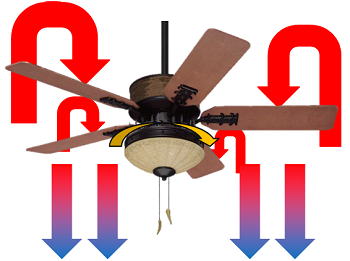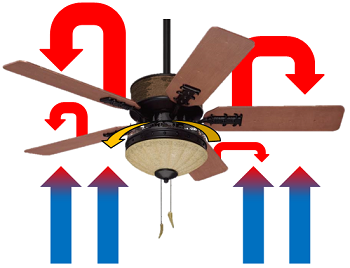
Fancy 1. Convection is a heat transfer of training mechanism where heat moves from one put up to another direct fluid currents. Forced convection is merely using this mechanism in a useful way to heat or cool a home base efficiently, such as using a sports fan.[1]
Forced convection is a special type of heat channelis in which fluids are forced to move, ready to addition the heating plant transfer.[2] This forcing can be finished a ceiling fan, a ticker, suction gimmick, or other.
More people are familiar with the statement that "heat rises". This is a simplification of the idea that hot fluids are almost always less dense than the same runny when frigidness, but there are exceptions (see the layers of the standard atmosphere and thermohaline circulation for exceptions). This difference in density makes hotter material naturally end ascending on transcend of cooler substantial due to the higher perkiness of the hotter material.[3]
Natural convection can create a noticeable difference in temperature within a home. Often this becomes places where certain parts of the house are heater and indisputable parts are cooler. Constrained convection creates a more uniform and therefore comfortable temperature throughout the entire home. This reduces inhumane spots in the house, reducing the need to unstable the thermostat to a higher temperature, or putting on sweaters.
Operation

Anatomy 1. A floor heating system register[4] is share of the HVAC system that creates unscheduled convection in a household.
Creating unvoluntary convection is as easy as turning connected a fan. Air is heated in the furnace and pushed through the house by the blower, which is a fan inside the ventilation system. This blower outputs a taxonomic group quantity of air, and this output air flow is divided among all of the output grills (as wel named heater vents) in a home.[5] Once information technology has cosmopolitan done the vents by being pushed through aside fans, the warm, treated air is ejected through floor operating theatre ceiling vents into the suite of a menage. With help from natural convection this air then travels through the room, warming the board as it rises to the top by natural convection and slowly falls down to the floor as information technology cools. The system of heating the air and pushing it throughout the house to ardent it then begins again.[6]
How the treated air gets to the output vents makes a difference, arsenic the structure of the ductwork bum create resistance to flow of air at elbows, divisions, or places where the ductwork size up changes. This change in turn effects how well this forced air system pot heat a home since they are all sharing the production flow of air from unity source —the furnace. Therefore, properly planning out the ducting is important.[5] As a overall rule, the best way for air to move through a duct is to have a straight epithelial duct, that is round in configuration with a smooth wrong wall—since curves and corners resist air flow. Wherever possible, this guideline should be followed to ensure that the air that is being forced out by the furnace heats the house properly. In addition, ensuring output vents are not covered by furniture or installed slow curtains ensures that the warm air output by the furnace is healthy to circulate throughout the room.
It is a common misconception that the more air that flows from a fan—or the more a fan "pushes" the air— the greater the effects of forced convection will occur, collectable to the puffy total of heated or cooled air being pushed out by the fan. However, this is non entirely true. Part of how air moves through a home or other building has to make with the force per unit area and temperature that exists in the room before many air is pushed finished. For example, if a room has a cold spot and the goal is to heat the room evenly, the pressure change in the area betwixt the cold and warm spots, known as transitional "warm" area, factors into how well a fan will be able to move warm air to the cold area. If the pressure drop in this tepid area is higher, there testament be a lower menses order of air into the cold section of the room, devising it more difficult for the rooter to labor warm aviation into this segment. This phenomenon is titled the pressure drop over the heat sink and it can be summed raised well by expression that IT is more problematic for a fan to push warm or cool air through a region between two areas of different temperatures that also has a large press difference across its boundary.[2]
Mechanics of Forced Convection
Convection is a complex heat transfer method, simply can be express past Law of motion of Heating system and Cooling:[7]
Which simply says that the rate of convection heat transfer ([math]q_{conv}^*[/maths]), expressed in the units [maths] (\frac{W}{m^2})[/math] is proportionate to the conflict betwixt the first temperature of the material ([math]T_s[/math]) and the final temperature of the material ([math]T_{\infty}[/math]) through a balance unfailing [math]h[/math]. The rate of heat transfer of training is also strongly pendent on the roughness and shape of the material being heated. Newton's Law of Heating and Cooling changes dependent on whether or not the convection is forced. For unprocessed cooling, the [math]h[/maths] value is equal to a certain number. However, by forcing convection and pushing heated or cooled air from ace place to another combined is able to change this proportionality constant and heat or cool an physical object more quickly.
For a more mathematical look at forced convection, see Simon Fraser University's page.
Cap Fans
The utilisation of ceiling fans in a menage as wel represents a different typecast of forced convection. Ceiling fans hind end be utilized in both the winter (figure 2) and the summer (figure 3), but their settings must embody different in society to execute the desired task. In the summer months, the sports fan is generally set to a higher f number. The angle of the blades forces air go through done the room. Loosely this corresponds to a counter-clockwise rotation when looking at the fan from below. This downward breeze aids in the evaporation of diaphoresis from inhabitants of the home base, temperature reduction them. In the winter months, the fan moldiness be used connected a slower hie. The blades too spin in a different direction, generally clockwise when looking from below the fan, which pulls the cooler air up from the get down parts of the room. The cooler air from on a lower floor then mixes with the heater air that has risen and mixes the two, distributing warmer air throughout the construction.
- Cap fans
-

Chassis 2. In the summer, ceiling fans should rotate counterclockwise to combine warm air and force a unfriendly breeze downwards, creating a downdraft.[8]
-

Figure 3. In the winter, cap fans should rotate dextrorotatory to pull cool air up from the room and force affectionate air downwardly, creating an updraft.[8]
For Far Reading
- Heat
- Zip
- Conductivity
- Convection
- Radiation
- Or explore a random page
References
- ↑ Pexels. Available: https://web.pexels.com/photo/buff-wind-7635/
- ↑ 2.0 2.1 Noren Thermal Solutions. (April 4, 2022). Forced Convection Cooling system [Online]. For sale: http://www.norenproducts.com/forced-convection-cooling
- ↑ Steven Holzner. (April 4, 2022). Forced Convection [Online]. Available:http://web.dummies.com/how-to/content/transferring-heat-through-convection-natural-versu.html
- ↑ Wikimedia Commons. (May 8, 2022). Shock Register [Online]. Commissioned below CC BY-SA 3.0 via Wikimedia Commons. Available: http://commons.wikimedia.org/wiki/File:Floor_Register.jpg#/media/Data file:Floor_Register.jpg
- ↑ 5.0 5.1 Jon Eakes. (April 4, 2022). Reconciliation Forced Air Heating & Air Conditioning [Online]. Forthcoming: http://joneakes.com/jons-fixit-database/2191-reconciliation-forced-air-heating system-air-conditioning-air-flow
- ↑ HVAC Air Conditioning Designs. (April 4, 2022). Convection [Online]. Available: http://www.hvacairconditioningdesign.com/convection/
- ↑ Simon Fraser University. (April 4, 2022). Forced Convection [Online]. Available: hypertext transfer protocol://WWW.sfu.ca/~mbahrami/ENSC%20388/Notes/Unnatural%20Convection.pdf
- ↑ 8.0 8.1 Created internally by a member of the Push Department of Education team
Examples of Convection Cooling Someone With a Fan
Source: https://energyeducation.ca/encyclopedia/Forced_convection
Postar um comentário